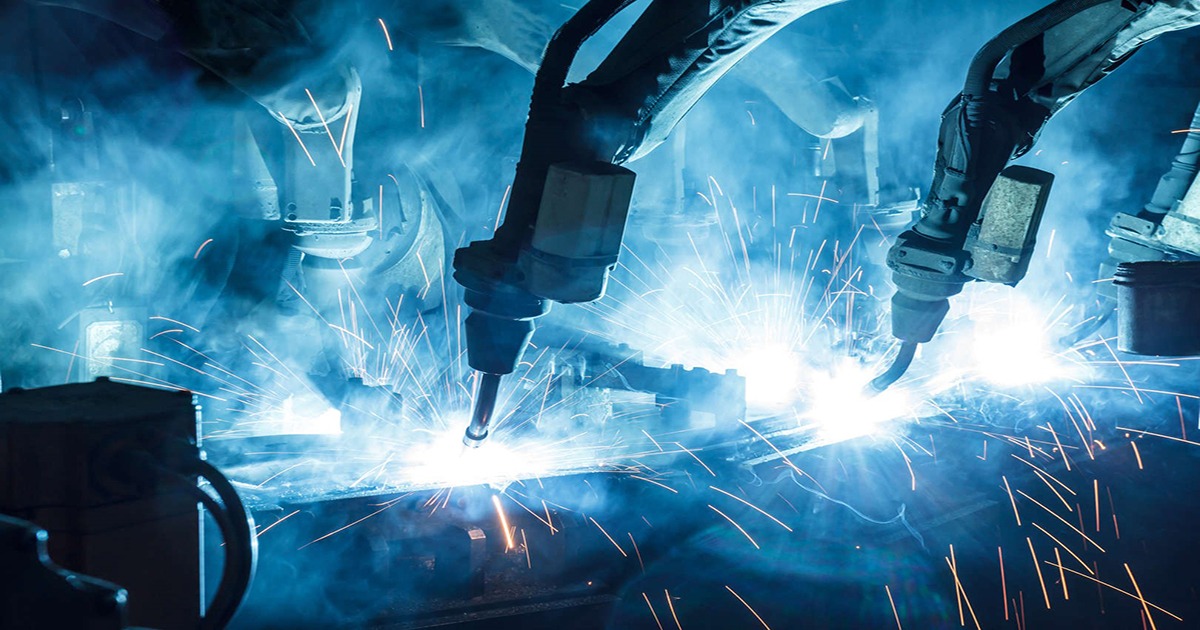Industry 4.0 is mainstream in A&D manufacturing, and attention is now turning to the new kid on the manufacturing block—Industry 5.0.
Although in its infancy, early understanding of Industry 5.0 is that it is not just made up of new technology but is all about a more encompassing approach to the use of such technologies in a societal environment helping build a sustainable and human-centric manufacturing industry.
With European and North American policy makers including Industry 5.0 in their future plans and projections, it is quickly becoming an established A&D manufacturing approach.
Here are the key tech-enabled developments powering Industry 5.0 for a better future.
1. Industry 5.0 shines the spotlight on human-robot collaboration—A.K.A Cobots!
Technology is providing stepping stones towards the core objectives of 5.0. IoT, additive manufacturing, augmented reality, and digital twins are processes that have gained credence in factories and assets making the output of manufacturing projects quicker, more efficient, and data driven.
This allowed a “digital thread” to be built across A&D equipment from design, to prototyping, manufacturing, and even in-service support. This is providing the perfect habitat for the collaborative robot, or “cobot”.
The International Centre for Industrial Transformation views Industry 5.0 as “…an add-on to Industry 4.0, building upon the groundwork laid by these smart technologies. While the focus of Industry 4.0 was connectivity, digitalization and automation, Industry 5.0 highlights the importance of human-robot collaboration and the relationship between man and machine, or ‘cobots’.”
5.0 will bridge the gap between man and machine
New technology applications emerging as part of Industry 5.0 focus more on the people executing the manufacturing—particularly to improve their physical capability and safety. In an A&D context, we are already seeing technology and equipment from a military background becoming commercialized.
2. It’s all about people—5.0 will alleviate labor shortages
The A&D sector is experiencing a workforce and skills gaps with as many as 69% of A&D manufacturing leaders agreeing that their organization’s turnover has significantly increased within the last 12 months—demonstrating the intense competition and lack of readily available labor. Survey results also showed that employees aged 55 and older represent 28% of the workforce, the highest of any age demographic.
Assistive wearables
The increasing development and use of the man/machine and technology/human interface can help provide immediate relief for current older workers and attract new younger generations into the A&D manufacturing workspace. Assistive wearable tech can help older workers achieve more power and productivity, putting less strain on them physically while boosting safety.
With this increasing digital focus, manufacturing is becoming a more exciting and desirable workplace once again. With more cutting-edge manufacturing and engineering tech, high-skills and high-paid jobs are becoming available as manufacturing becomes smarter and more intelligent.
3. The digital thread is essential to make A&D manufacturing personalized & agile
Hyper-personalization is becoming a part of everyday life for consumers. Make-to-order, configure-to-order, engineer-to-order, assemble-to-order are also becoming common requirements for A&D equipment manufacturing. Smarter factories and digitally focused products provide coherent digital thread that can feed data back into the manufacturing process to allow quick changes to improve design, fabrication, and performance.
A&D manufacturers need to stay agile, which means having key functionalities in the enterprise software they use. Take the example of Middle Eastern defense manufacturer Calidus, and the manufacturing of its Light Attack aircraft—which manages a complex process of delivering an aircraft or change order to a customer, with critical emphasis on getting the right part to the right place at the right time. IFS software takes away the burden from manual processes which previously could only be achieved by spreadsheet and individual work.
4. Keep an ESG eye on A&D manufacturing
A key part of the definition of Industry 5.0 is a focus on societal and sustainability goals. Implementing Industry 5.0 will have a positive impact on staff acquisition and retention, when workforce competition is extremely high. It will touch on the human-centric approaches not just on the factory floor, but from a strategic level throughout the company.
Sustainability pressures are not new issues for A&D manufacturing
A&D manufacturing CEOs are responding to sustainability pressures, but to address their environmental output, they need visibility. This is where the enterprise systems used to manage their value chain can help them adopt sustainable and circular manufacturing operations—including supporting manufacturing disassembly for component reuse and assigning sustainability measures and embedding them into business processes.
5. 5.0 will fuel supply chain consciousness initiatives
Industry 5.0 will also contain a focus on resilience. Onshoring and repatriation of outsourced manufacturing and shipping are huge focus areas for protecting supply chains while addressing environmental impacts of long-haul air and sea shipping—reflecting a potential pullback in the hyperglobalization we’ve seen over the last few decades.
Capgemini reflects this view in a recent report, Building resilience in Aerospace and Defense: “Designing flexible supply chains and responsive manufacturing and reducing dependences on less friendly states is now a matter of growing importance—giving rise to ‘onshoring’ (bringing sourcing and manufacturing back to the country) and ‘friendshoring’ (bringing these back to allied countries)… To deliver more flexible manufacturing, the massive global supply chains on which manufacturing relies must become more adaptive and more resilient.”
Enterprise technology will help lay the foundations for Industry 5.0
Research commissioned by IFS finds that 72% of senior decision-makers have increased their usage of domestic suppliers, compared to international suppliers. Technology will help deliver the agility and fast Time to Insight (TTI) that they need to forecast demand and provide a more detailed view across product supply chains.
Exceptional supply chain management will be a vital part of the move to reshoring. So, it was heartening to find that the IFS study showed supply chain management was seen by 37% of respondents as a top three priority their organization is trying to solve through technology investment.
SOURCE: MATTHEW M. (2024,MAY21). EET THE COBOTS, THEIR FRIENDS AND FAMILY—A&D MANUFACTURING GETS A HUMAN-CENTRIC INDUSTRY 5.0 MAKEOVER. IFS BLOG. https://blog.ifs.com/2024/05/meet-the-cobots-their-friends-and-family-ad-manufacturing-gets-a-human-centric-industry-5-0-makeover/

